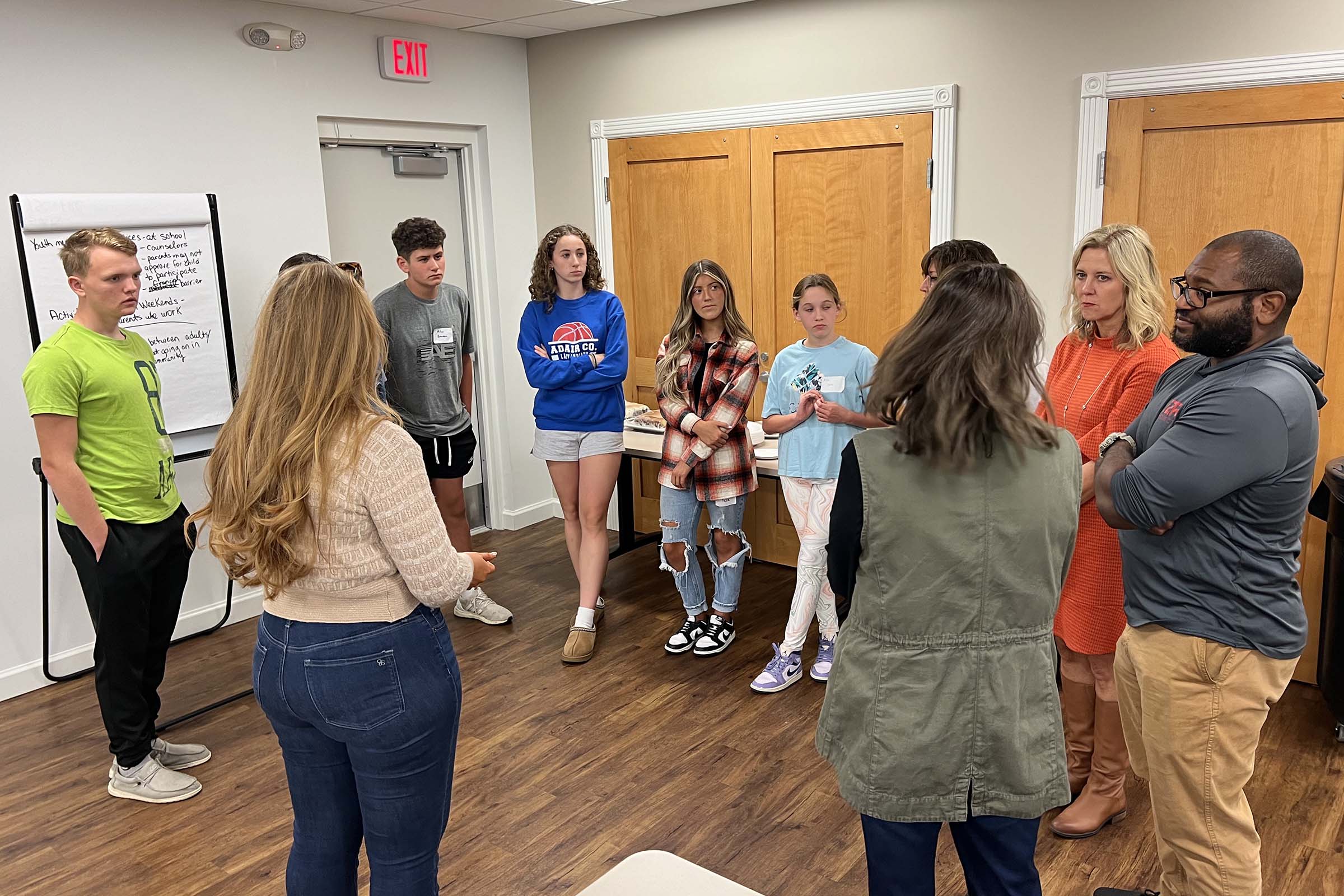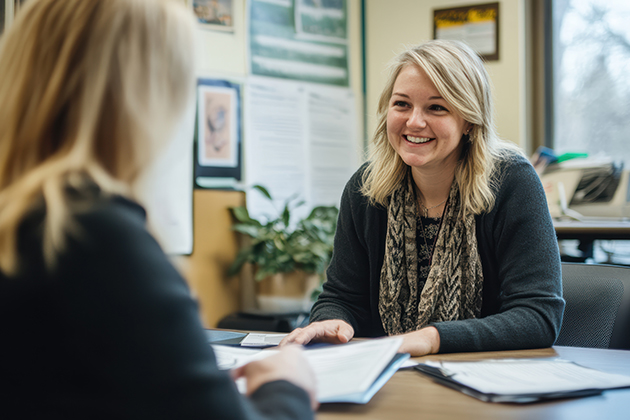How-To Guide | Youth & Adult Listening Sessions
How-To Guide | Youth & Adult Listening Sessions

INTRODUCTION
The Youth and Adult Listening Session is a low barrier activity that engages youth and community members in a facilitated conversation whose results can be used to inform program planning for organizations and service agencies. This toolkit is designed to assist community leaders and facilitators to plan, conduct, and follow up on a Youth and Adult Listening Session in their community.
Youth and Adult Listening Sessions provide a platform for youth ideas to be collected and shared by a neutral facilitator, fostering dialogue with attending adults and encouraging robust discussions on community issues that impact young people.
Youth Listening Sessions are an effective way to engage youth, ages 13 to 18, in thoughtful conversation, collect feedback, and catalyze that feedback into action.
These Sessions build upon many tenets of quality youth engagement (Hawke et al) which:
- Authentically values youth expertise
- Formally recognizes contributions
- Creates youth friendly spaces
- Creates meaningful opportunities and active participation
COMMUNITY IMPACT
In recent years, there has been a growing acknowledgment of the importance of meaningful youth engagement and the effectiveness of programs driven by user input. In an effort to implement best practices, organizations have seen success in involving youth in community driven initiatives. When youth contributions are genuinely valued, communication is clear, their roles are clearly defined, and their needs are considered, youth can and do offer valuable input (Hawke et al).
Adults leave these listening sessions with a newfound respect for the attending youth and the youth’s opinions, ideas, and views on issues discussed. Often, adult attendees are service providers in their communities, and attending these sessions can broaden their understanding of youth needs and potential services to offer.
“This workshop taught me that youth want to be involved in their development and want good things for their peers.”
Topics raised by youth in these sessions also mirror and reinforce topics that are commonly identified by communities at large. For instance, in the most recent Community Assessment conducted by Kentucky Cooperative Extension, the first three of the Top 15 Priority Issues were focused on addressing youth needs:
- Minimizing youth substance use
- Youth life skill training opportunities (e. g., leadership and communication skill building opportunities)
- Strengthening youth workforce readiness (including entrepreneurship, business development skills, etc.)
“I feel like I know more about what we need to change in this community.”
have been raised by youth in Youth and Adult Listening Sessions before:
- Ensuring individuals and families have access to affordable nutritious food
- Support for substance use addiction prevention/recovery
- Improved access to mental health and wellbeing resources
- Reducing youth obesity through nutrition education and/or exercise
- Minimizing bullying and/or school violence
- Building financial literacy and/or resource management skills
- Access to high-speed internet
- Strengthening youth-adult or mentorship relationships
- Social, emotional, and/or behavioral education for adults working with youth
“Feels good that so many youth & adults share same concerns. We can make positive change when we are all on the same page!”
PLANNING
Considerations
Thoughtful planning and preparation are key to a successful Youth and Adult Listening Session. When you are planning a session in your community, you will want to address the following:
- Goals - Goals can help determine potential partners, questions asked, and how to follow up. Identified goals can also help plan the session and guide the evaluation process. An inherent goal of the Youth and Adult Listening Sessions is to identify challenges facing youth.
- Partnerships - Youth and Adult Listening Sessions are an excellent opportunity to partner with other organizations in your community. These partners can help acquire space, provide materials and incentives, market the session to their audiences, and encourage participation.
- Location - Youth and Adult Listening Sessions should take place in a location where the group can be together in one large room and have space to break off into a youth group and adult group for the breakout sessions, preferably in separate rooms. Utilize local partnerships to identify a space appropriate for the session.
- Time Frame - Consider the barriers to participation for differing time frames such as working times for parents and guardians, limitations based on location, and lunch. Plan to allow 2.5 hours for the session, not including breaks or meals.
- Materials -
- Big sticky paper for note taking (like Post-it Easel Pads)
- Markers
- Sticky dots for voting (markers can also work)
- Pre and post surveys for evaluation
- Optional: candy or snacks for participants
- Marketing - Time, location, and partnerships can help determine the best marketing methods for the session. Marketing to youth may include distributing flyers and social media posts, while marketing to adults may involve sending personalized emails and using newspaper announcements in addition to social media. Use existing networks to work alongside or reduce the need for marketing efforts.
Goals
When setting goals, specify the exact community on which you will focus your discussion: the entire county, a particular city, or a cluster of rural areas?
Consider the following questions when setting goals for the session:
- What specific outcomes do we want to achieve through youth engagement?
- How will we ensure that youth voices are authentically valued and heard?
- What roles and responsibilities will youth have in this process?
- How will we provide the necessary support and resources for youth participants?
- What mechanisms will we use to gather and incorporate youth input into decision-making?
- How will we create an accessible and encouraging environment for all youth to participate?
- How will we measure the effectiveness of our efforts?
- What strategies will we use to maintain ongoing communication and feedback with youth participants?
- How can we address potential challenges to youth participation and engagement?
- What partnerships or collaborations can enhance our initiative?
- How will we celebrate and recognize the contributions of youth in this process?
- What follow-up actions will we take based on the input and feedback received from youth?
Partnerships
Once goals for your session have been identified, you will want to consider assembling a team to help meet the identified goals and assist in planning the session.
Some potential community partners to consider when planning a Youth and Adult Listening Session include:
- Cooperative Extension
- School System and Youth Services Directors
- Chamber of Commerce
- Local business owners
- Hospital/health care representatives
- Youth service organizations (YMCA, Scouts, etc.)
Time Frame
An ideal Youth and Adult Listening Session lasts a minimum of 2.25 hours:
- 15 minutes for introductions and pre-survey
- 1 hour for breakout sessions
- 45 minutes to share and compare findings
- 15 minutes for post-survey and closing
The timeline mentioned above does not include any time for breaks, which may be necessary. Many groups find success in pairing their session with a meal to incentivize participation and allow for natural conversation throughout the session. If a meal is to be added to the session, more time will be needed.
Sample Agenda
WHAT: Youth Needs Assessment for Adair County
WHEN: Friday October 13th , 2023, 8:00 AM – 1 PM
WHERE: Adair County Cooperative Extension Service
SCHEDULE:
| 8:00AM | REGISTRATION AND BREAKFAST |
| 8:30AM | WELCOME |
| 8:45AM | BREAK INTO ADULT AND YOUTH GROUPS FOR DISCUSSIONS |
| 10:00AM | BREAK |
| 10:15AM | BRING BOTH GROUPS TOGETHER FOR DISCUSSION |
| 11:30AM | WRAP UP |
| 12:00PM | LUNCH |
Marketing
Providing incentives can be a highly effective way to drive participation, but it can also be costly. Partners can be incredibly useful in this aspect of marketing the session, by providing a meal, such as lunch or dinner, or other incentives.
Existing collaborations may also eliminate or reduce the need for marketing efforts. For example, if Cooperative Extension and the local school system are collaborating to bring together youth for the session, they may already be working with or have identified a particular group to work with, or they may request flyers, social media posts, etc. to encourage youth to participate. Likewise for adults, if the Chamber of Commerce is a partner in session planning, they may encourage local business owners to attend the session. If not, finding a way to market to potential adults may include sending personalized emails, making an announcement in the local newspaper, or sharing on relevant social media outlets.
SESSION FACILITATION
Once the session has been planned, it is time to focus on facilitation.
Key Players
Though a community leader is needed for organizing the session and spearheading action, neutral facilitators are necessary for the success of the breakout sessions and group discussion.
You will need:
- Community Leader
- Neutral facilitators (at least 2)
- Adult participants (between 7 and 20)
- Youth participants (between 7 and 20)
Neutral facilitators create an unbiased atmosphere, bring new perspectives, ask tough questions, and challenge existing assumptions. You will need to share this guide with the selected neutral facilitators for this session.
Introduction
The community leader should start the session by welcoming the group, sharing the location of water/bathrooms/exits/etc., discussing the goals of the session, and ask participants to complete the pre-survey.
After the survey is completed, have adults share their names and organizations, and ask youth to share their names and ages, but also ask each group to answer a question (such as the ones listed below). One person will need to be designated a scribe to take notes on the responses to this question.
- If you could give one thing to every youth in _____ County, what would it be?
- What is the one thing you believe every youth in _____ County should experience?
- If you could provide one skill to every youth in _____ County, what would it be?
Breakout Session Discussions
The group will now be separated into an adult group and youth group for breakout sessions.
Using the list of “Breakout Discussion Questions” supplied (next page), neutral facilitators (one in each group) will read off and collect feedback on the various topics.
The facilitators may present “ground rules” for the conversation:
- Listen Actively: Pay attention to the speaker and show that you are listening through nodding and appropriate responses.
- Respect Others’ Opinions: Acknowledge that everyone has a right to their own perspective, even if it differs from yours.
- No Interruptions: Allow each person to finish their thoughts before responding. Wait your turn to speak.
- Use “I” Statements: Share your own experiences and feelings instead of generalizing or making assumptions about others.
Once ground rules are shared, it is time to begin the conversation. The neutral facilitator will ask each of the following questions (below) and capture responses using markers on the big sticky paper. Facilitators should check in with the group regularly to make sure that the captured notes accurately reflect what the participant was trying to share.
Facilitators should also define “community” for the group, as decided during the goal-setting process, and should reframe the question or provide follow up points if participants are struggling to answer.
Breakout Discussion Questions
- What is the most positive thing about your community?
- What do you want your community to look like in ten years?
- How do we make our community a place for young people to thrive after graduation? (Share these clarifying points – making it a positive place for youth to stay in a trade, go to college and return in future to live/work, or attract other young people from other communities to the area to live, work and play.)
- What are the biggest challenges in our county that affect youth?
- How can we address these challenges?
- If you had $500,000 to help address a challenge or issue in the community, what would you do with that money?
Full Group Discussion
At the end of the breakout session, the groups will come back together to compare answers.
Each group should identify someone to share the findings from the breakout session – either the neutral facilitators or a youth and adult participant from each group. The reporter should provide context around some responses, sharing takeaways from the conversations in the breakout sessions. Neutral facilitators should highlight both similarities and differences in the youth and adult group responses.
After responses to the “What are the biggest challenges in our county that affect youth?” question are read aloud, use the questions (below) to guide a group discussion around the identified challenges, while a scribe takes notes on the conversation.
- Are the identified challenges currently being addressed?
- What does the community do now that helps youth the most? Is the target population involved or reached effectively? And if not, how can they be encouraged to be involved?
- Are organizations that offer youth services overlapping or duplicating services? Examples?
- What services do youth need that are not available in our community/county?
- Are there any other topics, concerns, needs that we need to address or “shed light on” today?
Close the discussion after sharing responses to the final two breakout session questions.
Prioritizing Challenges
After sharing responses, it will be time to prioritize the identified challenges. Take both big note sheets from the breakout sessions that identify challenges and put them side by side. Ask if any other challenges should be added to each list, referring to the discussion notes.
When a comprehensive list of challenges is compiled, provide sticky dots or markers to participants for voting. Either neutral facilitators or the community lead should ask the larger group to identify what they see as the top three challenges youth face in their community. Be sure to give some direction to distinguish between youth and adult voters. For example, youth might use green sticky dots to identify challenges, and adults will use pink. Or if using markers, youth can use a star to mark their votes and adults can use checkmarks.
Tally the votes and share out the top 3 challenges as identified by youth and the top 3 challenges as identified by adults. Provide time and space for group reflection:
- Did you notice any common themes or patterns in the discussion?
- What did you find most valuable or insightful from our discussions today?
- Were there any perspectives or ideas that challenged your thinking?
- Can you share any takeaways from today’s discussion?
The community lead should direct participants to complete the post-survey. After survey completion, the community lead should end the session by thanking participants and share how the information collected will be used.
Optional Collaborative Activity
If possible, try to include time in the agenda for this activity. Number off participants so that there are small groups of both youth and adults. Provide each group with a sheet of big paper and a marker.
Assign each group one of the identified challenges and instruct them to work together to develop an action plan to address that challenge. Remind them to consider current services and barriers. After 10 minutes, have a spokesperson from each group share the group’s work.
EVALUATION
Pre/Post Survey
The evaluation tool that follows is a pre/post survey using a Likert scale. It is designed to identify what participants hoped to gain from their participation in the session, and rate what they actually gained from the program. This tool allows facilitators to report a change in skills, knowledge, and attitudes.
An example of Likert responses would be asking participants to answer with a number, one to five, where:
- = Strongly Disagree
- = Disagree
- = Neither Agree nor Disagree
- = Agree
- = Strongly Agree
Why Use Likert Responses
- Measures Attitudes and Opinions
- Ease of Use
- Range of Responses
This type of survey is easy to understand and complete for a wide range of participants. Likert responses allow for participants to report how strongly they feel on different topics, which along with their comments, helps to fully capture the opinions of both youth and participating adults. These collected responses can then be easily totaled and reported.
The notes collected during the session, paired with the numbers collected from the pre/post surveys, can add layers to conversations around challenges facing youth.
Pre-Survey Questions |
Post-Survey Questions |
| What do you hope to gain by participating in this workshop? |
What is the most important thing you will take away from this workshop? OR Has this workshop met your expectations? In what ways? Please explain. |
|
Rate your current skills/knowledge in the following areas – on a scale from 1-5:
|
Rate your current skills/knowledge in the following areas – on a scale from 1-5:
|
|
Rate the accuracy of each statement as it relates to you – on a scale of 1-5: In my county, I can:
|
Rate the accuracy of each statement as it relates to you – on a scale of 1-5: In my county, I can:
|
|
Overall, do you feel your skills/knowledge/attitude has improved after participating in the workshop? In what ways? Please explain. |
CONCLUSION
Follow UP
Follow up to the youth and adult listening session is vital to maintaining youth engagement. Review the goals set at the beginning of the process. How can the information collected be used to meet those goals?
Organizers should set a meeting date to review results and continue to make action items at 3 months, 6 months, and 9 months post-event to gauge progress towards goals. Maintain communication with partners and look for opportunities to collaborate. Make findings public for other organizations and leaders to use when decision making or planning.
Parting Thoughts
Many young people feel as though they must leave their community for opportunities around education or their preferred career path. Asking young people what their expectations are for the future and working to create that infrastructure for their future success is necessary for keeping young people in a community or persuading them to return.
Youth and Adult Listening Sessions help to meet this need by providing space for youth to discuss personal challenges, challenges faced by their peers, and opportunities to implement solutions in their communities.
To ensure that youth engagement is not tokenized, it is not enough to merely listen: youth participation in decision-making must be genuine and investment in the infrastructure that creates environments where young people choose to stay, thrive, and contribute must follow.
REFERENCES
About the Authors
In keeping with their mission to “Catalyze positive change to build engaged communities and vibrant economies,” Community and Economic Development Initiative of Kentucky (CEDIK) at University of Kentucky has facilitated numerous Youth and Adult Listening Sessions across the Commonwealth, working with Kentucky Cooperative Extension, to engage youth in their communities.
Mercedes Fraser, Extension Specialist with CEDIK, works to engage rural youth in both identifying and cultivating solutions to issues in their community through design and leadership development. Mercedes applies social theory and practical processes to community issues to establish effective and sustainable solutions.
CEDIK’s Engagement Director, Melody Nall, focuses her work on building healthy communities. Melody utilizes data-driven, evidence-based approaches and community engagement strategies to equip communities, so that they can foster a healthy population and workforce that in turn contributes to a thriving, healthy economy.
Tony Rose is the 4-H Youth Development Extension Agent in Adair County, KY. Tony is passionate about youth success and worked with CEDIK to host a Youth and Adult Listening Session in Adair county in 2023.
References
“Community Assessment.” Extension, 2023, https://extension.ca.uky.edu/community-assessment-0
Hawke, Lisa D, et al. “Engaging Youth in Research Planning, Design and Execution: Practical Recommendations for Researchers.” Health Expectations : An International Journal of Public Participation in Health Care and Health Policy, U.S. National Library of Medicine, Dec. 2018, https://www.ncbi.nlm.nih.gov/pmc/articles/PMC6250868/
4-H Youth Development, Cooperative Extension Service, University of Kentucky


